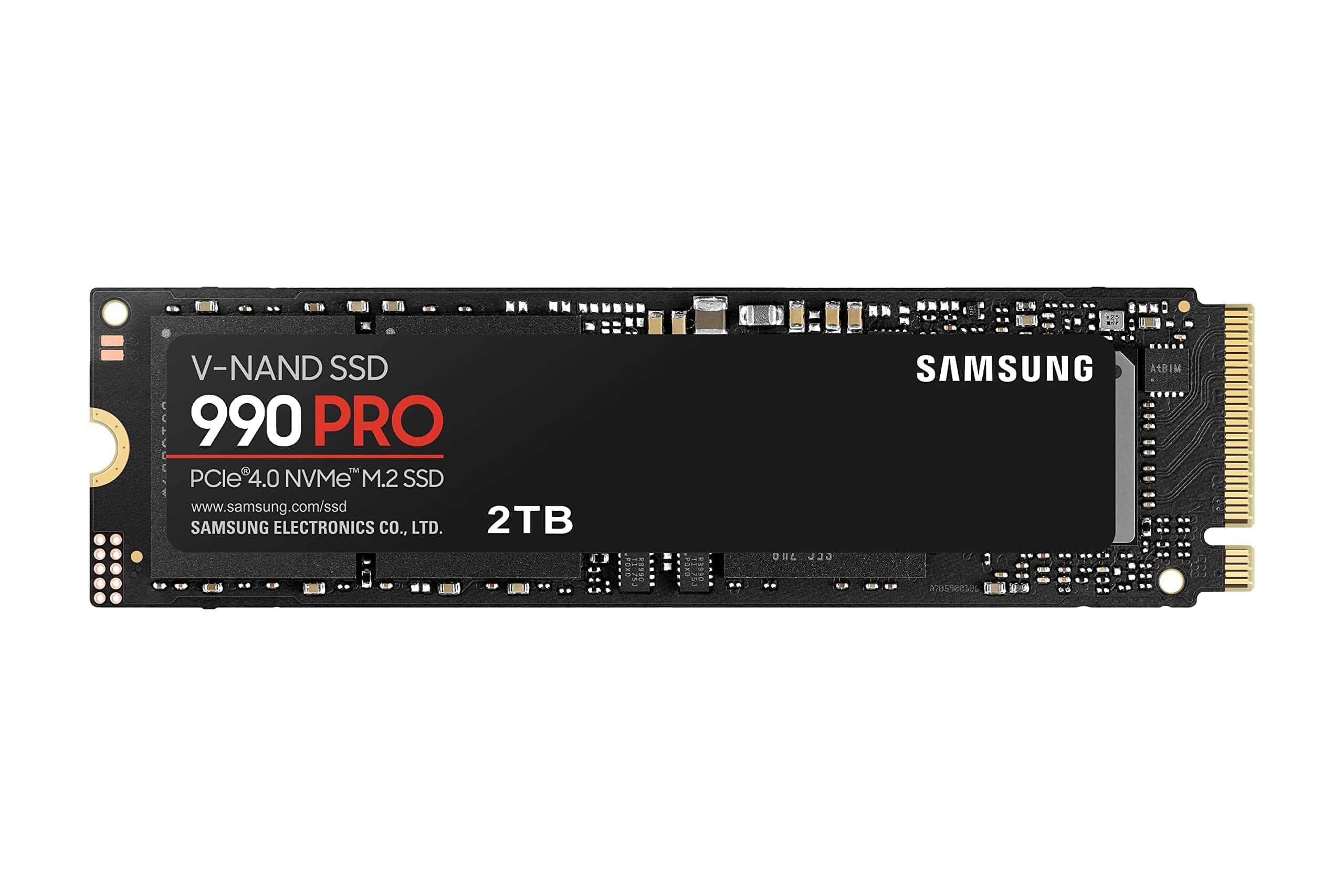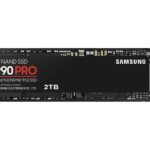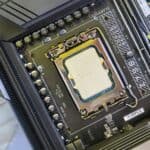In 2025, M.2 SSDs have fully cemented their place as the gold standard for internal storage in both desktops and laptops. Their compact form factor, superior speeds, and ease of installation make them a must-have for any modern system. Whether you’re a gamer, a video editor, or just looking to give your computer a serious speed boost, an M.2 NVMe SSD is one of the most impactful upgrades you can make.
Unlike older 2.5-inch SATA drives, M.2 SSDs connect directly to your motherboard through a dedicated M.2 slot, eliminating cables and minimizing installation complexity. Most modern models utilize the NVMe protocol over PCIe, significantly reducing latency and increasing data throughput. PCIe 4.0 drives can achieve up to 7,400 MB/s read speeds, while early PCIe 5.0 models now boast theoretical speeds of up to 14,000 MB/s — though the real-world performance benefit depends heavily on your hardware.
Choosing the Right M.2 SSD
There are several critical factors to consider when selecting an M.2 SSD for your build:
- Interface: PCIe 3.0 remains widely compatible and affordable, PCIe 4.0 offers excellent performance, and PCIe 5.0 is cutting-edge but requires newer motherboards and CPUs.
- Capacity: Ranges typically span from 250GB to 4TB. A 1TB SSD is the sweet spot for most users.
- Speed: Measured in MB/s for read/write and IOPS for random access tasks.
- Endurance: Look for TBW (terabytes written) ratings to assess long-term durability.
- Thermal Design: Drives with built-in heatsinks or thermal pads perform better during sustained workloads like gaming or 4K video editing.
Keep in mind that longer drives (e.g., 2280 — 22mm wide, 80mm long) are the standard and most motherboards are built to accommodate them. However, always verify compatibility before purchase.
Best M.2 SSDs in 2025
The market is full of great choices, but these are the standout models worth considering this year. Whether you’re building a high-end gaming rig or upgrading a work laptop, there’s an option for every budget and performance level.
| Rank | SSD Model | Price |
|---|---|---|
| 1 | Samsung 990 PRO M.2 SSD | Click to Check |
| 2 | Samsung 990 EVO Plus 1TB SSD | Click to Check |
| 3 | WD_BLACK SN850X 2TB Gaming SSD | Click to Check |
| 4 | WD_BLACK SN770 Gaming SSD | Click to Check |
| 5 | Kingston NV3 1TB SSD | Click to Check |
| 6 | Crucial P3 Plus 1TB NVMe SSD | Click to Check |
| 7 | Crucial P3 1TB NVMe SSD | Click to Check |
| 8 | Silicon Power P34A60 512GB NVMe SSD | Click to Check |
| 9 | Silicon Power UD90 M.2 SSD | Click to Check |
| 10 | TEAMGROUP MP33 512GB NVMe SSD | Click to Check |
These drives were selected based on a combination of speed, reliability, thermals, and real-world performance under gaming and productivity workloads.
PCIe 4.0 vs PCIe 5.0: Do You Really Need the Latest?
While PCIe 5.0 drives promise mind-blowing sequential speeds, most users won’t fully utilize that bandwidth outside of extremely specialized tasks like 8K video production or enterprise-level data analytics. PCIe 4.0 continues to be the best value, with drives like the Samsung 990 PRO and WD_BLACK SN850X offering top-tier speeds and stability for less than newer Gen5 drives.
However, if you’re building a system with the latest Intel 14th-gen or AMD Ryzen 9000-series processors and a motherboard with PCIe 5.0 slots, you can future-proof your system by picking up a Gen5 SSD now — just expect to pay more for marginal gains.
Tips for Installation and Longevity
Installing an M.2 drive is typically a plug-and-play experience, but here are a few quick tips:
- Use the included standoff and screw to secure the drive properly.
- Enable “XMP” or “DOCP” in BIOS (on systems that support it) for optimized memory and SSD performance.
- If your drive doesn’t come with a heatsink, consider adding one — especially for Gen4 or Gen5 drives under heavy load.
- Keep firmware up to date using tools like Samsung Magician, WD Dashboard, or Crucial Storage Executive.
Bottom Line
M.2 SSDs are no longer a luxury — they’re a necessity. Whether you’re gaming, editing, or just want a faster PC experience, these drives represent the best upgrades available for the money. Choose a model that aligns with your system’s interface support, workload, and budget to maximize both speed and longevity.
Best M.2 SSDs in 2025
M.2 SSDs offer incredible speed in a compact form factor, making them ideal for upgrading both laptops and desktops. These drives connect directly to your motherboard, eliminating cable clutter while delivering significantly faster performance than traditional SATA SSDs. Our list highlights the top M.2 drives available right now, considering factors like speed, reliability, and value for different user needs.
Samsung 990 PRO M.2 SSD
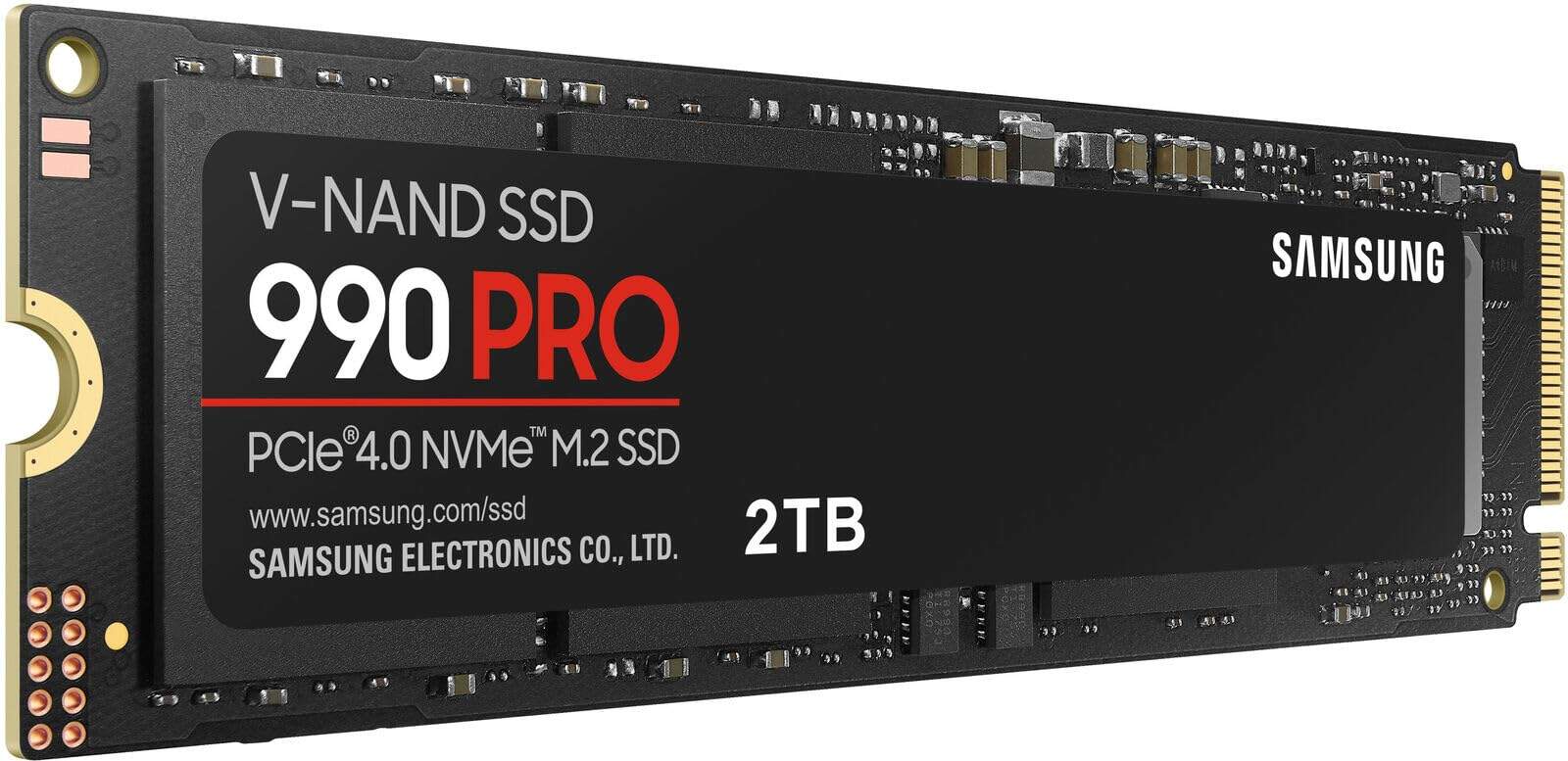
The Samsung 990 PRO offers exceptional performance for demanding users who need blazing-fast storage for gaming, content creation, or heavy workloads.
Pros
- Lightning-fast read/write speeds up to 7450/6900 MB/s
- Improved power efficiency over previous models
- Available in capacities up to 4TB
Cons
- Premium price point
- Requires PCIe 4.0 support for maximum performance
- Can run warm under sustained loads
Samsung’s flagship 990 PRO NVMe SSD represents a significant leap forward in storage technology. This Gen4 drive delivers near-maximum PCIe 4.0 performance with sequential read speeds reaching 7450 MB/s and write speeds of 6900 MB/s. Users will notice immediate improvements in system responsiveness, game loading times, and file transfers.
The drive shows a 55% boost in random performance compared to its predecessor, the 980 PRO. This enhancement makes a real difference in everyday computing tasks where small, random data access matters most. Samsung has also improved power efficiency by 50% over the previous generation, allowing the drive to maintain peak performance without excessive battery drain in laptop applications.
Storage options range from 1TB to 4TB, providing ample space for large game libraries, video projects, or professional workloads. The 2TB model strikes a good balance between capacity and cost for most users. Samsung backs the drive with their reputation as a leading flash memory manufacturer and includes software for drive management and optimization.
Compatibility requires a motherboard with PCIe 4.0 support to achieve maximum performance. While the drive will work in PCIe 3.0 systems, speeds will be limited by the interface. For PC gamers, content creators, and professionals who need fast, reliable storage, the Samsung 990 PRO delivers exceptional performance that justifies its premium positioning.
Samsung 990 EVO Plus 1TB SSD
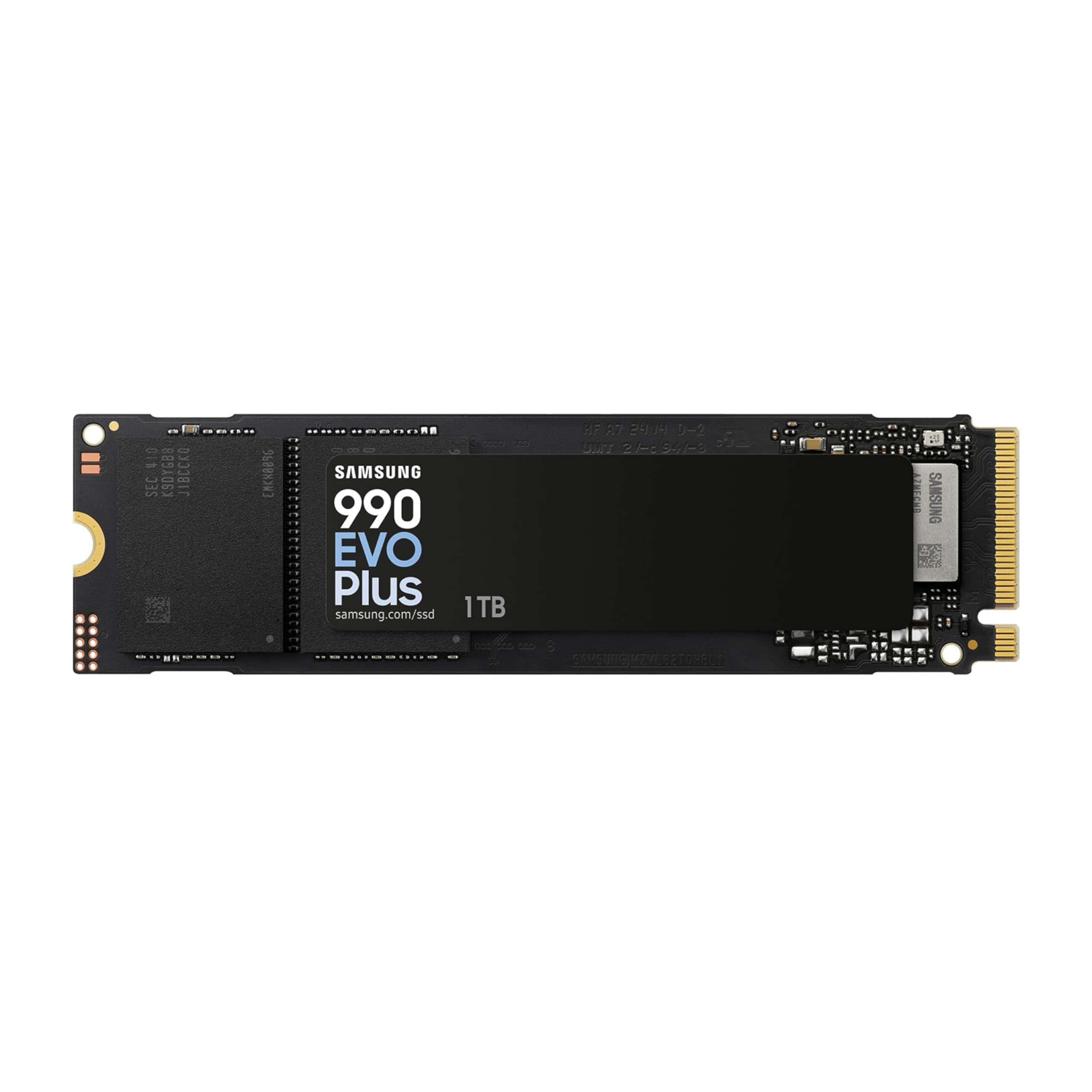
The Samsung 990 EVO Plus delivers exceptional speed and reliability for users seeking a premium M.2 SSD solution without overpaying for features they won’t use.
Pros
- Blazing fast 7,250/6,300 MB/s read/write speeds
- Excellent thermal management with nickel-coated controller
- Flexible compatibility with both PCIe 4.0 and 5.0 systems
Cons
- Higher price point than budget alternatives
- Requires modern motherboard for maximum performance
- Power users may want even faster PCIe 5.0 x4 drives
The 990 EVO Plus represents Samsung’s commitment to balanced performance in the M.2 SSD market. Released in late 2024, this drive bridges the gap between everyday SSDs and ultra-premium options. Its dual compatibility with PCIe 4.0 x4 and PCIe 5.0 x2 interfaces ensures users can get maximum performance from both current and next-generation systems.
Heat management stands out as a significant improvement over previous models. The nickel-coated controller reduces power consumption while maintaining performance levels. This design choice means the drive stays cooler during intensive tasks without sacrificing speed or requiring additional cooling solutions.
Samsung’s Intelligent TurboWrite 2.0 technology provides consistent performance during large file transfers. The drive maintains high speeds even when moving substantial data loads—a common pain point for lesser SSDs. Storage capacity options extend up to 4TB, making this drive suitable for gamers, content creators, and professionals who work with large files.
Software support adds considerable value to this package. The Samsung Magician software offers firmware updates, health monitoring, and extra security features. This utility helps maintain optimal performance throughout the drive’s lifespan and provides peace of mind for users storing important data.
Measuring just 3.2 x 0.9 x 0.1 inches, the 990 EVO Plus fits easily into laptops and compact desktop builds. Its slim form factor doesn’t compromise on performance or durability. The standard M.2 2280 size ensures broad compatibility with most modern systems built in the last few years.
WD_BLACK SN850X 2TB Gaming SSD
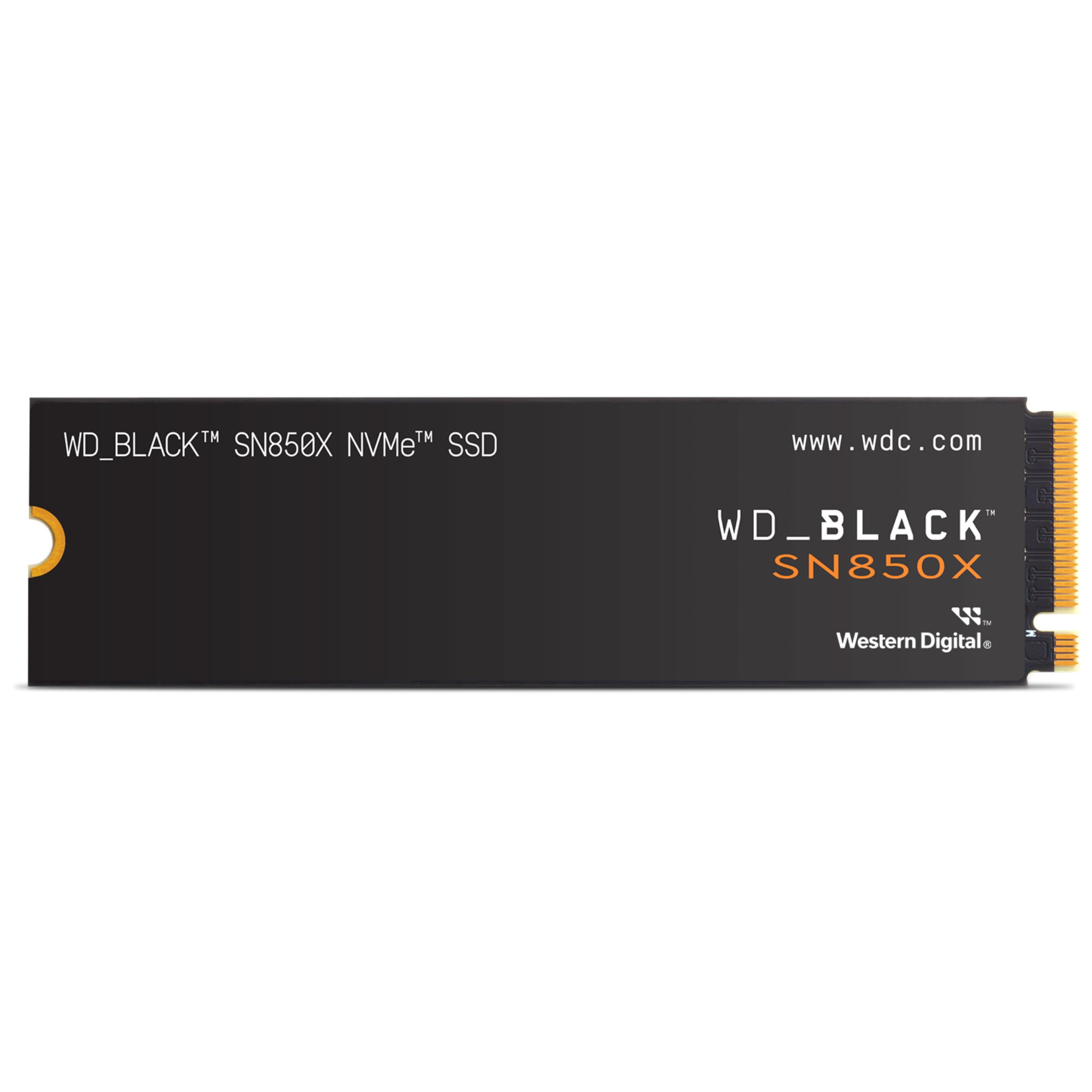
The WD_BLACK SN850X delivers exceptional speed and performance that makes it a top-tier choice for serious gamers and content creators who need lightning-fast storage.
Pros
- Blazing speeds up to 7,300 MB/s eliminate loading bottlenecks
- Available with optional heatsink to maintain peak performance
- User-friendly dashboard with Game Mode 2.0 optimization
Cons
- Premium price compared to budget NVMe options
- Heatsink model may not fit in all laptop configurations
- Requires PCIe Gen4 for maximum speed benefits
The SN850X represents WD_BLACK’s premium gaming storage solution with impressive read speeds that crush load times for demanding games and applications. Its Gen4 PCIe interface enables data transfers up to 7,300 MB/s, making it significantly faster than previous generation SSDs. Gamers will notice the difference immediately with reduced texture pop-ins and smoother gameplay.
Available in capacities from 1TB to 4TB, this M.2 SSD provides ample space for large game libraries without constant uninstall cycles. The 2TB model hits the sweet spot for most users, balancing cost with capacity. Western Digital’s TLC 3D NAND technology ensures reliable performance and durability over the drive’s lifespan.
Heat management sets the SN850X apart from competitors. The optional heatsink version prevents thermal throttling during intensive gaming sessions or large file transfers. This cooling solution maintains peak performance when it matters most. For PC builds with limited space, the non-heatsink variant remains available.
WD_BLACK’s Dashboard software adds extra value by monitoring drive health and automatically enabling Game Mode 2.0. This feature utilizes predictive loading and overhead balancing to optimize performance specifically for gaming workloads. The drive also supports Microsoft’s DirectStorage technology, future-proofing it for next-generation gaming experiences.
Installation proves straightforward in most modern motherboards with M.2 slots. The standard 2280 form factor ensures wide compatibility across desktop and some laptop systems. Users should verify their system supports PCIe Gen4 to get the full benefit of the drive’s capabilities.
WD_BLACK SN770 Gaming SSD
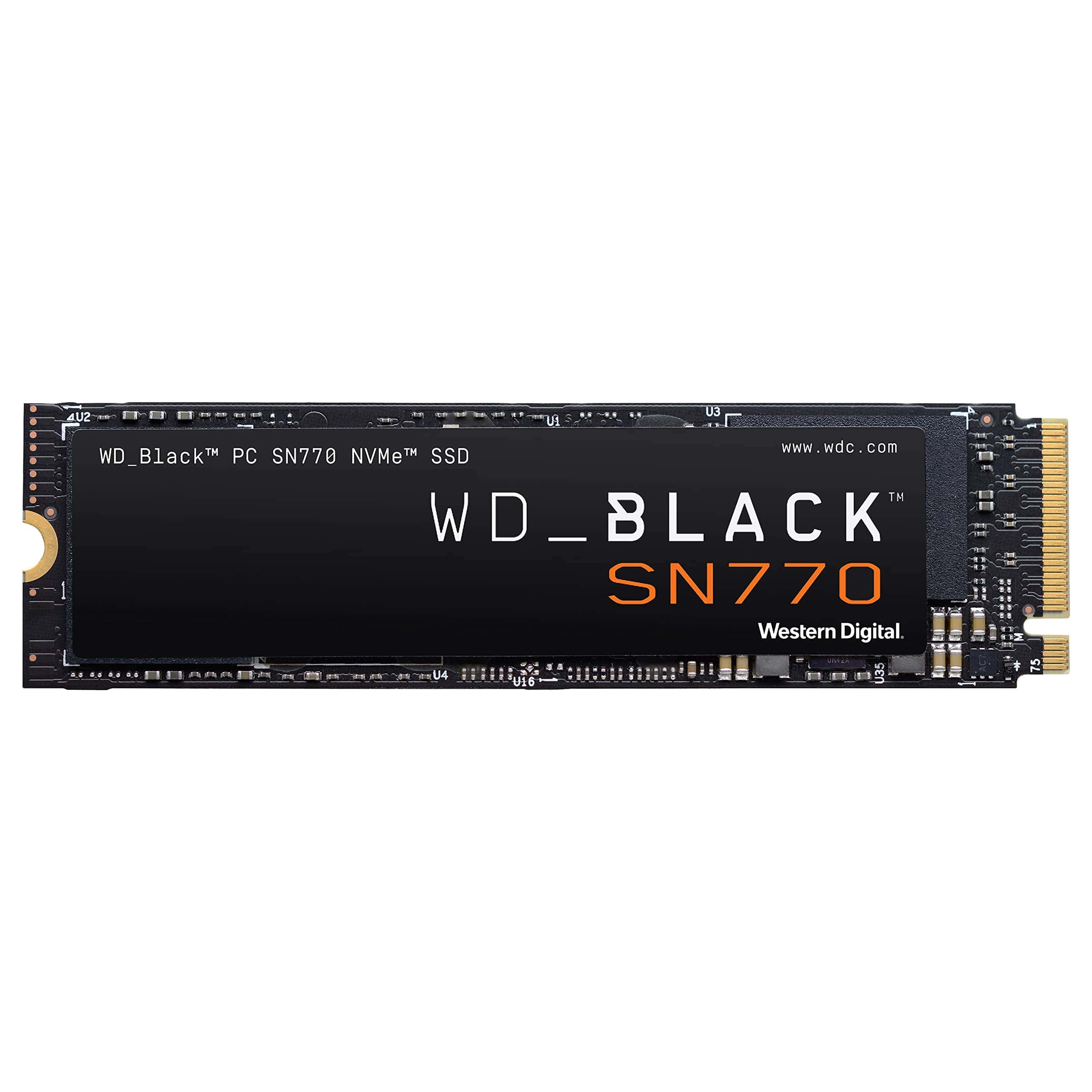
The WD_BLACK SN770 delivers exceptional gaming performance with blazing PCIe Gen4 speeds, making it an excellent choice for gamers wanting faster load times and smoother gameplay.
Pros
- Lightning-fast read speeds up to 5,150MB/s that dramatically reduce game loading screens
- Compatible with future Microsoft DirectStorage technology for next-gen gaming performance
- Backward compatibility with PCIe Gen3 systems offers upgrade flexibility
Cons
- Requires a compatible PCIe Gen4 motherboard for maximum speed potential
- No included heatsink may require additional cooling in high-performance systems
- Dashboard software limited to Windows users only
Western Digital’s gaming-focused SN770 NVMe SSD stands out in the crowded storage market. This M.2 drive delivers impressive performance jumps of up to 40% faster speeds compared to previous generations. The 2TB model provides ample space for modern game libraries, which frequently exceed 100GB per title.
Performance gains are most noticeable during gaming sessions. Players experience significantly reduced load times and smoother gameplay with minimal stuttering. The drive’s PCIe Gen4 interface pushes data transfer speeds up to 5,150MB/s, though users with older motherboards can still benefit from its backward compatibility with PCIe Gen3.
Power efficiency has also improved in this model. The SN770 uses up to 20% less power at maximum speeds compared to its predecessor. This makes the drive a smart choice for gamers who want both performance and efficiency. The WD_BLACK Dashboard software adds value by letting users monitor drive health and optimize performance through a dedicated gaming mode.
Installation proves straightforward with the standard M.2 2280 form factor fitting most modern gaming PCs and laptops. With over 21,000 positive reviews and a 4.8-star rating, the SN770 has earned its reputation as a reliable performer. For gamers looking to eliminate loading screens and improve system responsiveness, this drive delivers exceptional value at its price point.
Kingston NV3 1TB SSD
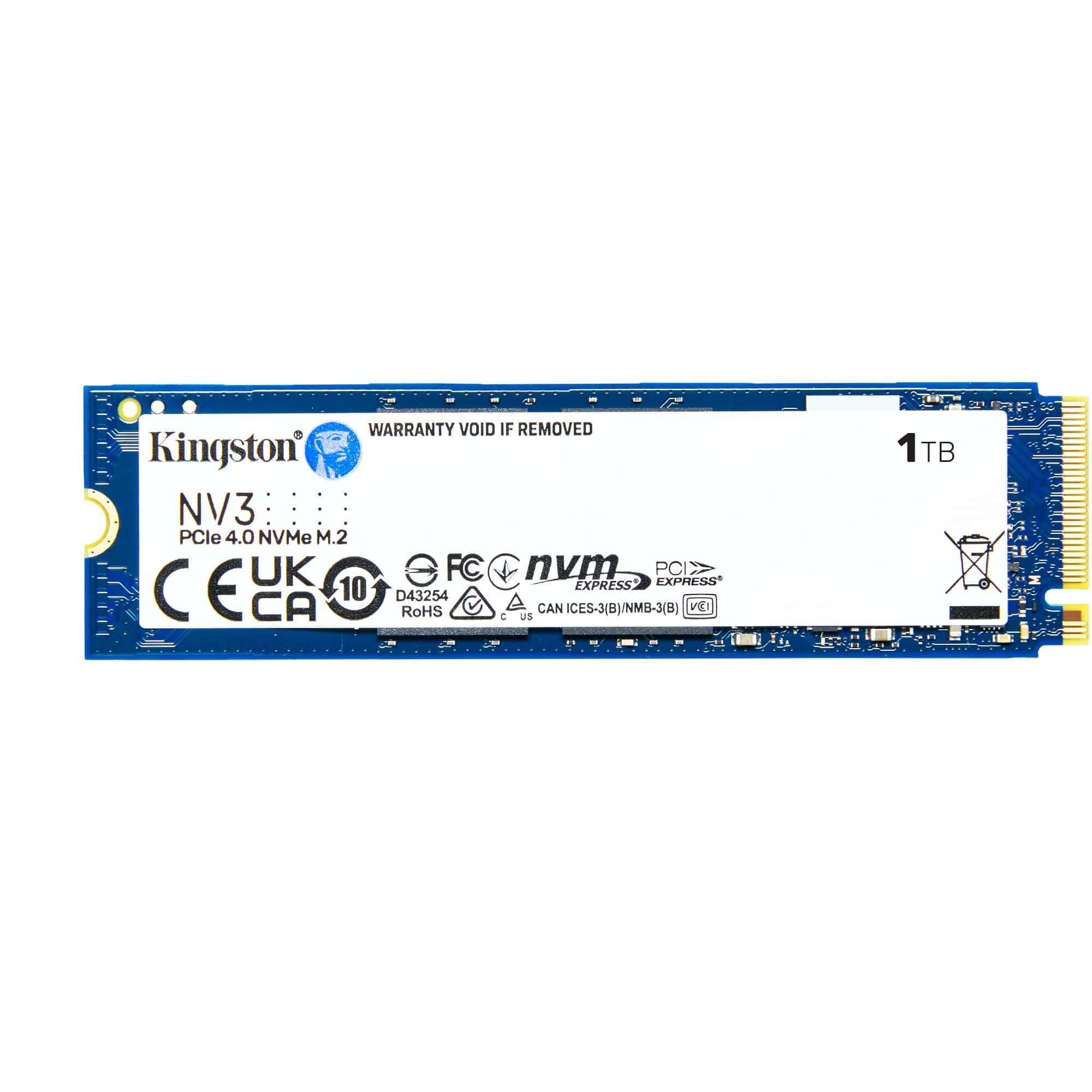
This PCIe 4.0 NVMe drive delivers excellent performance at a competitive price point, making it a smart upgrade for most PC users seeking better storage speeds.
Pros
- Fast PCIe 4.0 speeds up to 6000MB/s read performance
- Low power consumption generates less heat
- Single-sided M.2 design ensures broad compatibility
Cons
- Actual speeds may vary based on system limitations
- No included migration software
- Blue color might not match all PC builds
Kingston’s NV3 represents the newer generation of M.2 storage with its PCIe 4.0 interface. Users upgrading from SATA SSDs or older NVMe drives will immediately notice significant performance improvements in boot times and file transfers.
Performance tests show the drive delivers impressive speeds, though actual results depend on the motherboard and CPU combination. Some users report achieving around 3500MB/s on systems limited to PCIe Gen 3, which highlights the importance of checking system compatibility before purchase.
The single-sided design proves particularly valuable for laptop upgrades where space is at a premium. With 1TB capacity, most users will find ample room for operating systems, applications, and games without constant storage management.
Heat output remains minimal during extended operations, which benefits both desktop and laptop applications. The drive doesn’t require additional cooling solutions in most cases, though systems with heavy workloads might benefit from motherboards with built-in M.2 heatsinks.
Installation follows the standard M.2 process with no special considerations required. The drive gets recognized instantly by Windows and other operating systems, needing only basic formatting before use.
Value represents one of the NV3’s strongest aspects. Kingston has positioned this drive competitively against other PCIe 4.0 options, making high-performance storage accessible to more budget-conscious builders and upgraders.
Crucial P3 Plus 1TB NVMe SSD
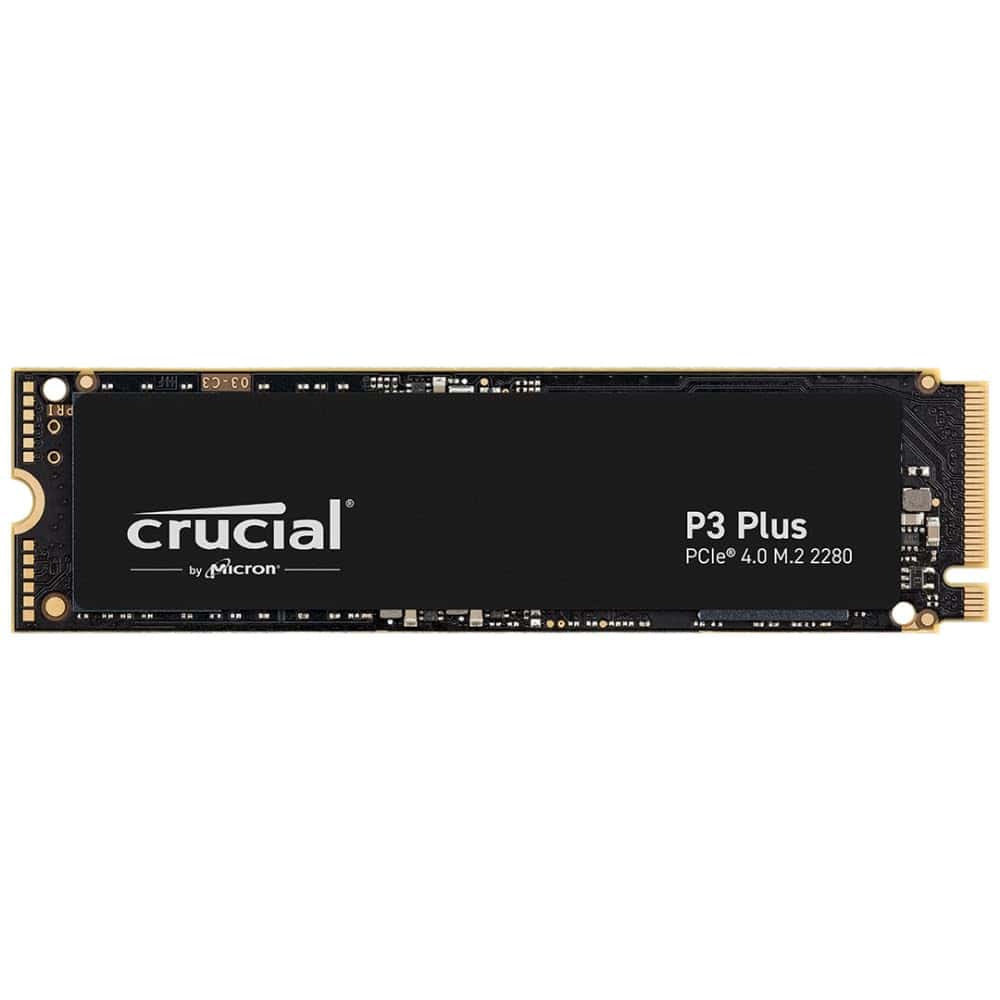
The Crucial P3 Plus delivers impressive Gen4 performance at a competitive price point, making it an excellent choice for users seeking speed without breaking the bank.
Pros
- Exceptional speed with up to 5000MB/s read and 4200MB/s write speeds
- Backward compatible with Gen3 systems for flexibility
- Reliable design with MTTF rating exceeding 1.5 million hours
Cons
- Not the absolute fastest Gen4 drive available
- Runs warmer during intensive operations
- Limited software suite compared to some competitors
This M.2 SSD strikes an impressive balance between performance and affordability. The P3 Plus leverages PCIe Gen4 technology to achieve speeds up to 43% faster than top Gen3 drives. Users upgrading from traditional hard drives or older SSDs will immediately notice significantly improved system responsiveness and reduced load times.
Crucial designed this drive with versatility in mind. The backward compatibility with Gen3 systems makes it an excellent option for users planning future upgrades. Available in capacities up to 4TB, the P3 Plus provides ample space for large game libraries, creative projects, or extensive file storage without compromising on speed.
Heat management deserves consideration with any high-performance storage. The P3 Plus incorporates adaptive thermal protection to prevent data loss during intensive operations. For optimal performance in systems with heavy workloads, additional cooling solutions might benefit this drive during extended sessions. Dynamic write acceleration helps maintain consistent performance even as the drive fills up.
Installation proves straightforward in compatible systems with an M.2 slot. The slim 2280 form factor fits easily in most modern motherboards and laptops supporting NVMe drives. Engineered by Micron with 3D NAND technology, the drive delivers reliable performance with impressive longevity ratings that should outlast several system upgrades for most users.
Crucial P3 1TB NVMe SSD
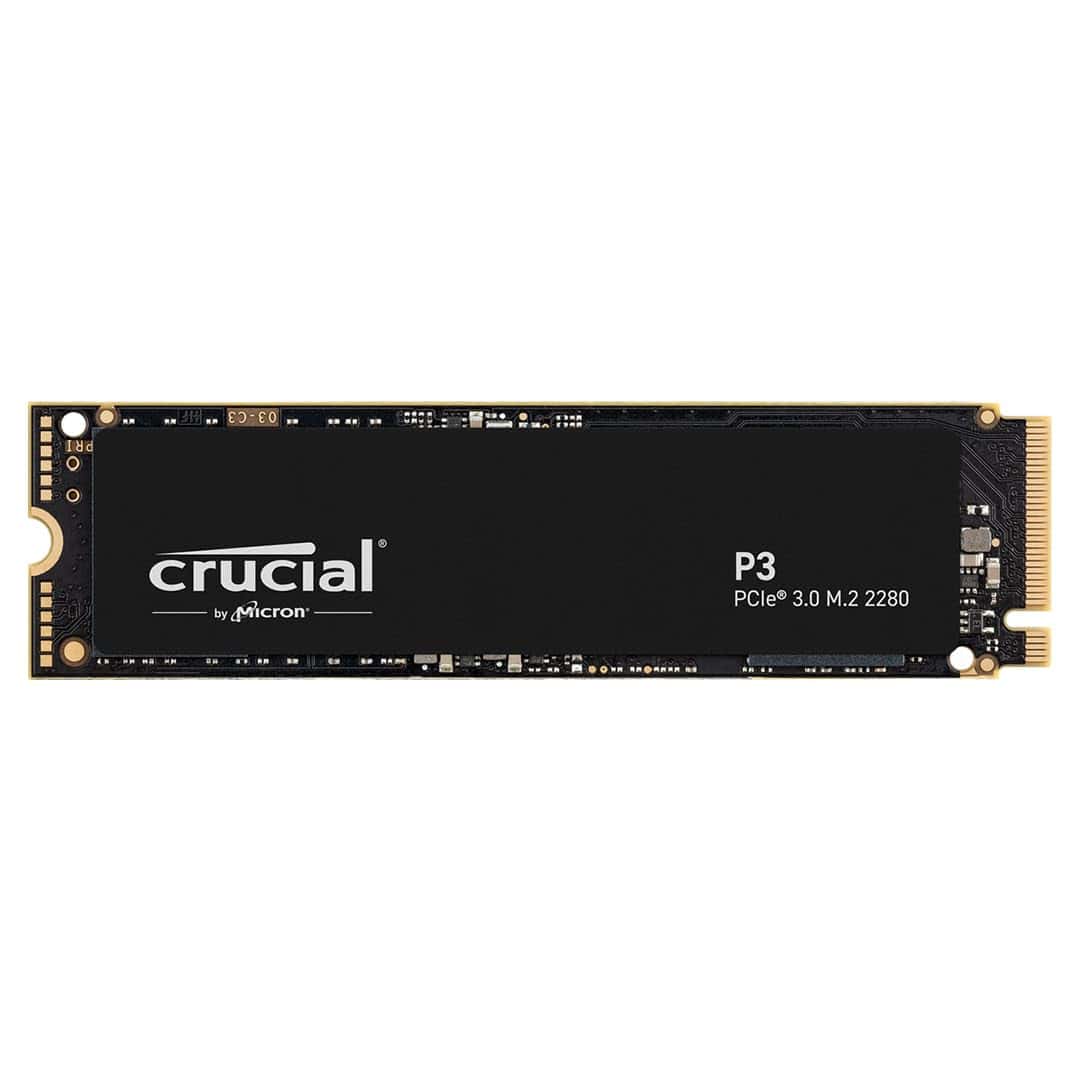
The Crucial P3 delivers impressive Gen3 NVMe performance at a budget-friendly price point, making it an excellent value upgrade for users looking to boost their system’s storage speed.
Pros
- Nearly 5x faster than SATA drives with sequential reads up to 3500MB/s
- Excellent reliability rating with MTTF greater than 1.5 million hours
- Available in capacities up to 4TB for substantial storage expansion
Cons
- Uses PCIe Gen3 rather than newer Gen4 technology
- Controller may throttle under sustained workloads
- Not the fastest NVMe option for professional content creators
This M.2 SSD strikes an excellent balance between performance and affordability. The Crucial P3 offers read speeds up to 3500MB/s and write speeds up to 3000MB/s, significantly outpacing traditional SATA SSDs without the premium price tag of Gen4 models. Users upgrading from older storage will notice dramatic improvements in boot times, file transfers, and overall system responsiveness.
Micron’s advanced 3D NAND technology powers this drive, providing solid endurance for everyday computing tasks. The P3 performs about 33% better than Crucial’s previous generation, showing meaningful improvements in random read/write speeds (650K/700K IOPS). These specifications translate to smooth multitasking and faster application loading in real-world usage.
Compatibility remains straightforward with the Crucial P3. The drive works with any desktop or laptop that supports PCIe NVMe Gen3, making it a versatile upgrade option. Installation requires minimal technical knowledge, though users should verify their system has an available M.2 slot before purchasing. The slim 2280 form factor (80mm length) fits most modern motherboards without space constraints.
The P3 launched in June 2022 and has garnered impressive customer feedback, maintaining a 4.7-star rating across over 27,000 reviews. This robust satisfaction record speaks to the drive’s reliability and performance consistency. For users seeking affordable NVMe speed without paying for cutting-edge Gen4 technology, the Crucial P3 delivers exceptional value.
Silicon Power P34A60 512GB NVMe SSD
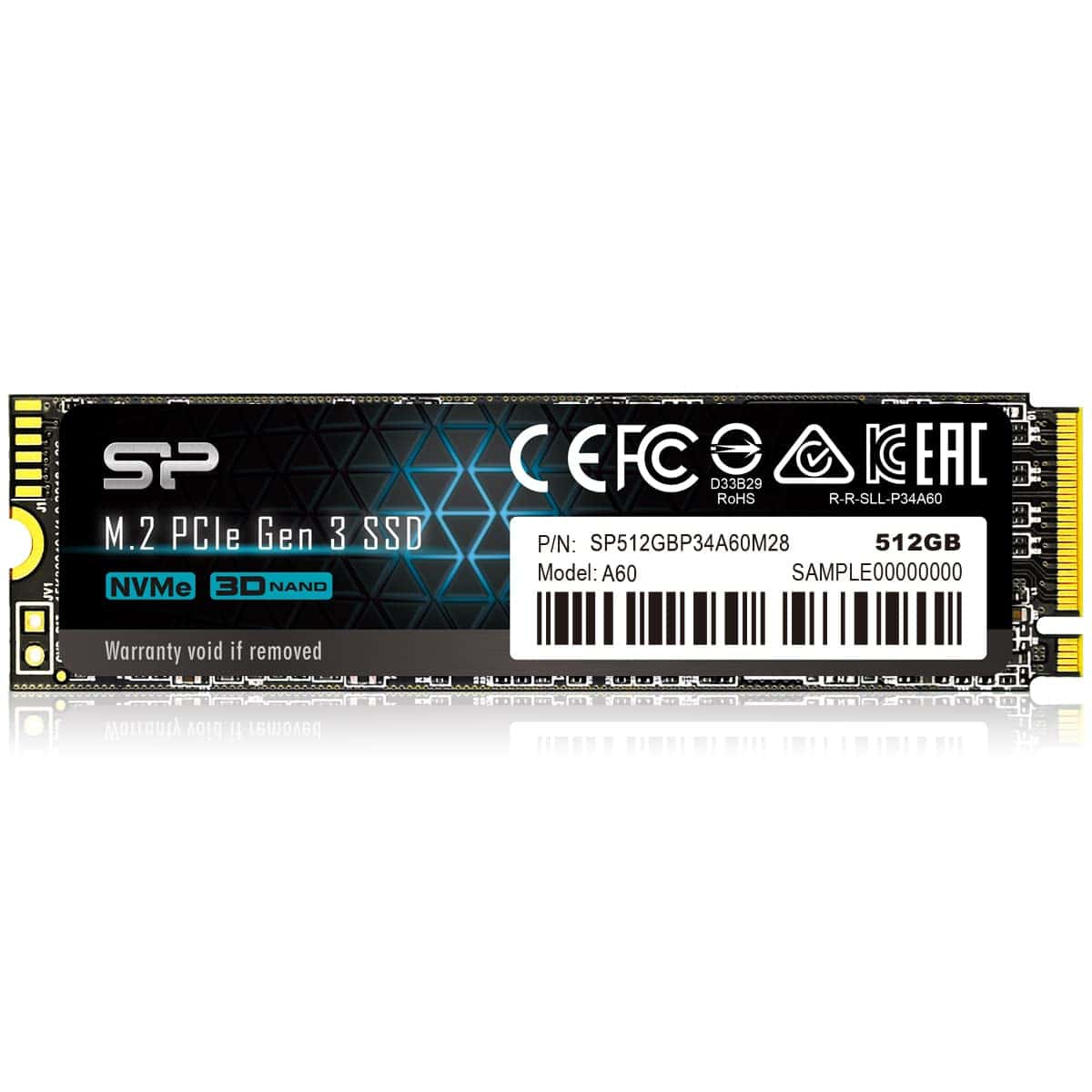
The P34A60 delivers excellent performance at an affordable price point, making it an ideal choice for users looking to upgrade their storage without breaking the bank.
Pros
- Impressive read/write speeds for the price (2,200/1,600 MB/s)
- Strong data protection features including LDPC coding and E2E protection
- Compact M.2 2280 form factor fits laptops and small PCs
Cons
- Requires a motherboard with M.2 slot supporting PCIe
- Not the fastest option compared to newer Gen4 SSDs
- Installation may need a specific screw not included in package
The Silicon Power P34A60 represents a solid entry-level NVMe SSD option for users wanting to step up from traditional SATA drives. With PCIe Gen3x4 interface, this drive achieves read speeds up to 2,200 MB/s and write speeds up to 1,600 MB/s, providing a noticeable performance boost for everyday computing tasks.
One standout feature is the drive’s advanced data protection suite. The P34A60 incorporates LDPC coding for error correction, End-to-End data protection for transfer integrity, and a RAID engine that enhances overall reliability. These security measures help maintain data stability without compromising performance.
Installation requires a compatible M.2 slot with an M key, which most modern motherboards include. The drive’s 80mm (2280) form factor makes it widely compatible with laptops and desktop systems. Users should note that while the drive performs well for its price class, those needing the absolute fastest speeds may want to consider pricier PCIe Gen4 options.
For system builders or upgraders on a budget, the P34A60 hits a sweet spot between cost and capability. The drive offers reasonable endurance with a TBW (Terabytes Written) rating of 300, sufficient for typical consumer workloads. Storage capacity options extend up to 2TB, allowing users to choose what best fits their needs and budget.
Silicon Power UD90 M.2 SSD
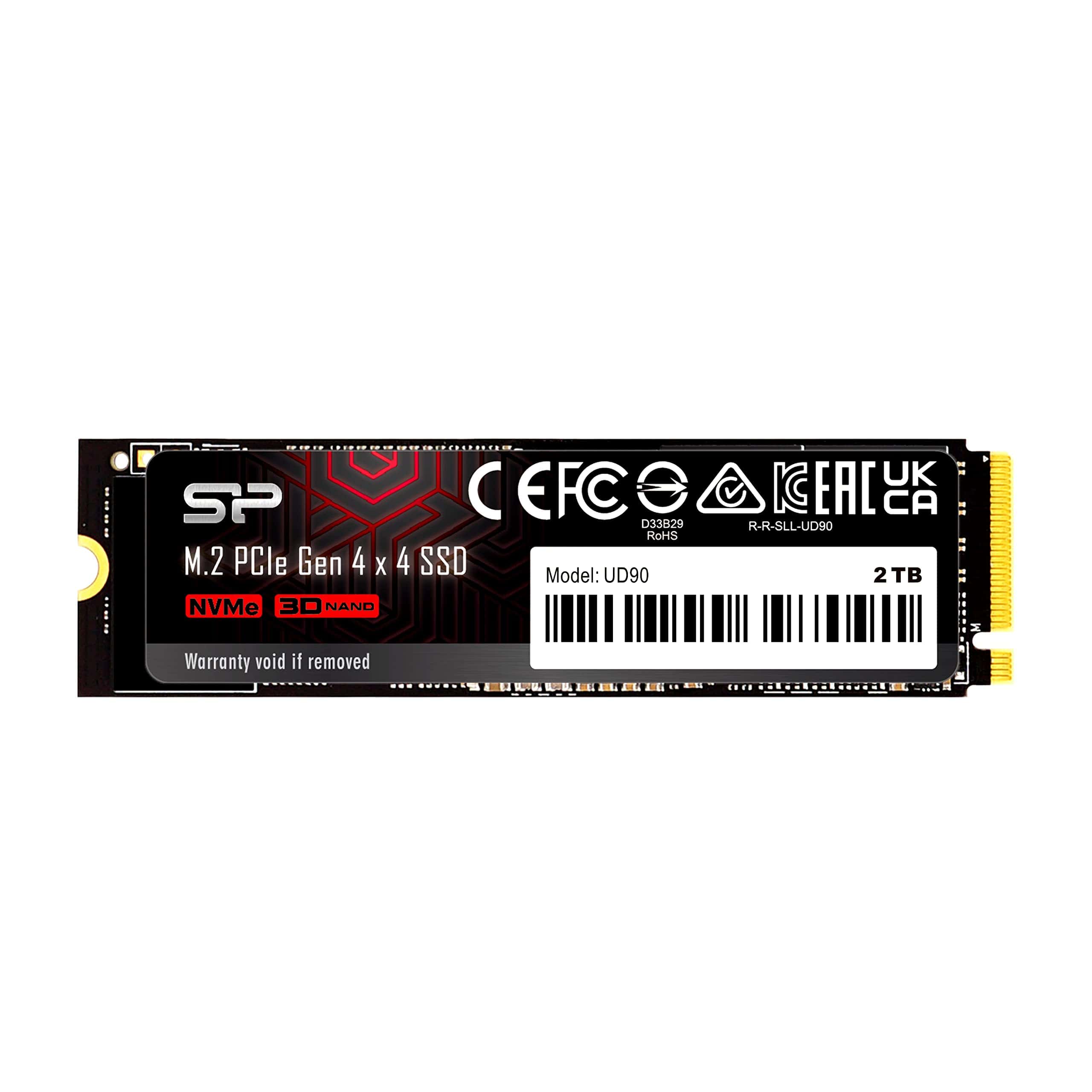
The Silicon Power UD90 offers excellent PCIe 4.0 performance at a budget-friendly price point, making it an ideal choice for users wanting to maximize speed without breaking the bank.
Pros
- Impressive 5,000MB/s read and 4,500MB/s write speeds
- Budget-friendly price compared to other PCIe 4.0 drives
- Includes 5-year warranty for peace of mind
Cons
- Some users report compatibility issues in certain systems
- Not the absolute fastest PCIe 4.0 drive available
- Heat generation may require adequate cooling
The Silicon Power UD90 brings PCIe 4.0 performance to budget-conscious shoppers. This M.2 SSD delivers significantly faster speeds than previous generation drives, with sequential read speeds reaching up to 5,000MB/s and write speeds up to 4,500MB/s. Users upgrading from SATA SSDs or PCIe 3.0 drives will notice immediate improvements in boot times, game loading, and file transfers.
Built with reliability in mind, the UD90 incorporates several data protection features. It supports SLC caching to maintain consistent performance during intensive tasks. The drive also includes low density parity check (LDPC) coding for data transmission accuracy and end-to-end data protection to safeguard against unexpected failures.
Compatibility with PCIe 4.0 motherboards unlocks the UD90’s full potential, nearly doubling the bandwidth compared to PCIe 3.0 interfaces. This translates to faster download times and improved multitasking capabilities. For those with older systems, the drive remains backward compatible with PCIe 3.0, though at reduced speeds. At 2TB capacity, this model provides ample storage for large game libraries, media collections, and production files.
TEAMGROUP MP33 512GB NVMe SSD
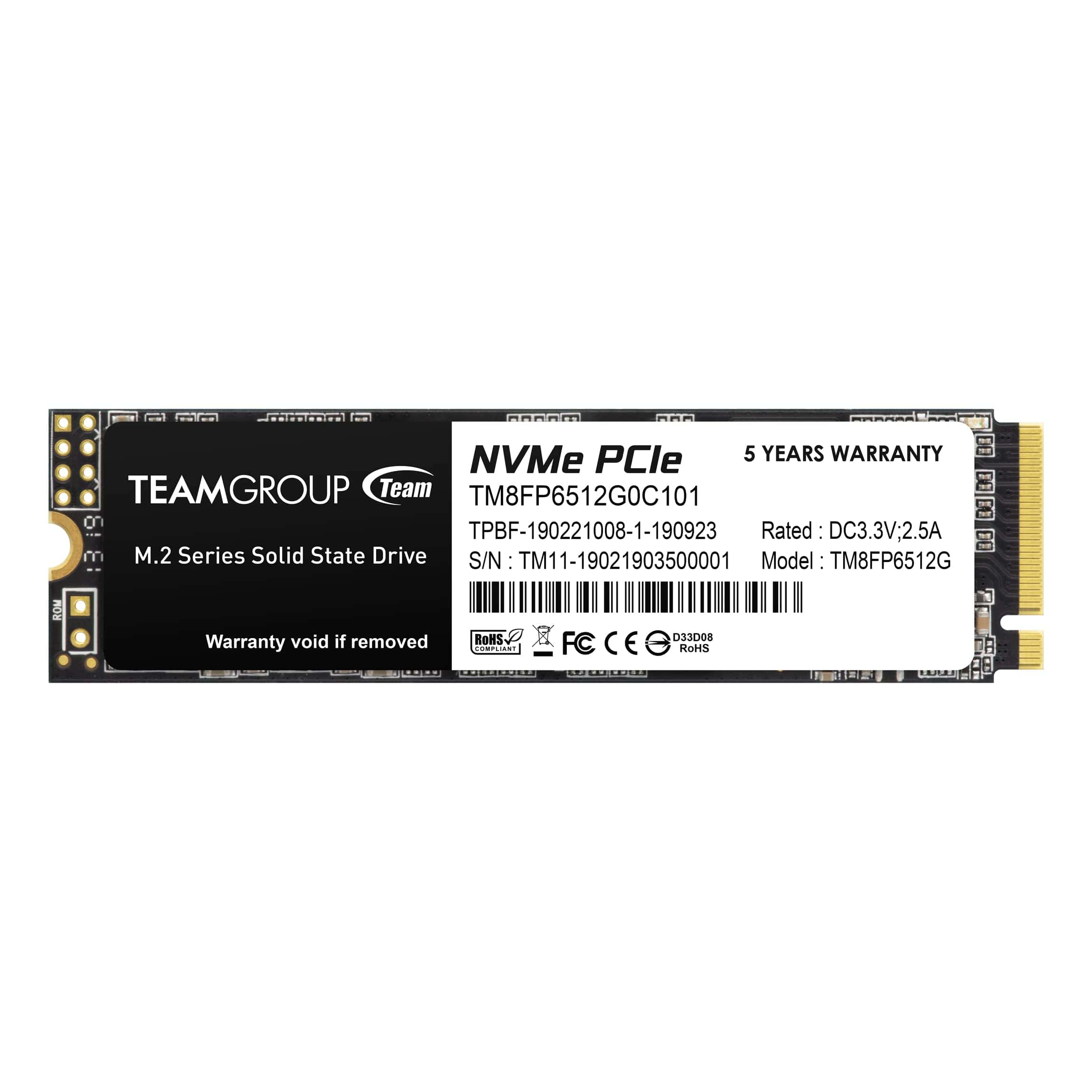
The TEAMGROUP MP33 offers solid performance at an affordable price point, making it an excellent choice for users seeking to upgrade from traditional hard drives without breaking the bank.
Pros
- Fast PCIe Gen3x4 interface with speeds up to 1700/1400 MB/s
- Budget-friendly price compared to premium NVMe drives
- Compatible with both laptops and desktop systems
Cons
- Performance lags behind newer PCIe Gen4 SSDs
- Limited endurance rating compared to premium alternatives
- SLC cache can slow down during extended write operations
TEAMGROUP’s MP33 512GB SSD delivers a significant speed boost over traditional SATA drives. With read speeds reaching 1700 MB/s and write speeds of 1400 MB/s, this drive performs up to five times faster than SATA SSDs. Users will notice quicker boot times and snappier application loading when upgrading from older storage solutions.
The M.2 2280 form factor ensures wide compatibility across modern systems. This drive works seamlessly with both Intel and AMD platforms, making it versatile for desktop or laptop upgrades. Installation requires just a compatible M.2 slot and a few minutes to secure the drive in place.
SLC caching technology helps the MP33 maintain good performance for everyday tasks. This feature temporarily treats a portion of the TLC NAND as faster SLC memory, boosting speeds for common operations. While heavy workloads may eventually saturate the cache, typical users won’t encounter this limitation during normal computing activities.
Value-conscious shoppers will appreciate the MP33’s balance of performance and price. Though not the fastest NVMe drive available, it delivers substantial improvements over SATA drives without commanding premium prices. For gaming, general productivity, and everyday computing, the speed difference between this drive and more expensive options often becomes negligible in real-world usage.
Buying Guide
When selecting an M.2 SSD, several key factors will influence your purchase decision. Storage capacity should be your first consideration, with options typically ranging from 250GB to 4TB.
Performance specifications matter significantly. Look at the read/write speeds measured in MB/s and IOPS (Input/Output Operations Per Second). These numbers indicate how quickly data transfers to and from the drive.
Interface Types
| Interface | Max Speed | Compatibility |
|---|---|---|
| SATA III | 600 MB/s | Widest compatibility |
| PCIe 3.0 | 3,500 MB/s | Modern systems |
| PCIe 4.0 | 7,000 MB/s | Newest systems |
| PCIe 5.0 | 14,000 MB/s | Latest high-end systems |
Form factor is another critical element. M.2 SSDs come in various lengths (2242, 2260, 2280, 22110), with 2280 (22mm x 80mm) being the most common.
Endurance Ratings
Endurance ratings, measured in TBW (Terabytes Written), tell you how much data can be written to the drive before potential failure. Higher TBW values indicate better durability for intensive workloads.
Power efficiency becomes important for laptop users. Look for drives with lower power consumption to maximize battery life.
Warranty length often correlates with expected drive quality and longevity. Most quality M.2 SSDs offer 3-5 year warranties.
Heat dissipation features like built-in heatsinks can prevent thermal throttling during intensive operations. These are especially valuable for high-performance drives.
Budget constraints will ultimately guide your decision. Balance your performance needs with what you can reasonably afford.

